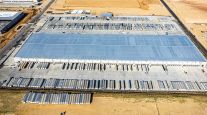Improved Transport Infrastructure Seen Helping Mexico ‘Insourcing’
This story appears in the Nov. 19 print edition of Transport Topics.
ANAHEIM, Calif. — Mexico continues to become an increasingly desirable manufacturing and freight market for reasons ranging from more competitive labor costs to improved transportation infrastructure, carriers and their customers agreed at an industry meeting here.
“There has been tremendous insourcing to Mexico,” said Dick Smith, vice president of Sears Holdings Management Corp., citing an increase in shipments by Sears to 30,000 loads last year from 2,000 a few years before. He spoke at the National Industrial Transportation League’s TransComp and the Intermodal Association of North America’s Expo.
“It is a question not only of Mexico being able to compete with other manufacturing nations, but also that the transportation infrastructure in Mexico has been improved,” Smith said.
From the carrier side, one of the latest initiatives is the plan by U.S. Xpress Enterprises to take 90% control of former joint venture Xpress Internacional and to form a joint venture with another Mexican carrier (see story, p. 31).
“This move extends and expands our service in Mexico, said John White, executive vice president of U.S. XPress. “Actions such as near-shoring in Mexico have made that more attractive.”
White said cross-border freight generates $120 million annually at present, without forecasting future growth. The original 2007 joint agreement called for equal partnership between U.S. XPress and two Mexican private financers.
The carrier’s new investment is in a company called Logisti-K, which gives the U.S carrier new access to interior points in Mexico, as well as the authority to provide nontrucking services such as freight forwarding and warehousing.
Jon Panzer, assistant vice president of intermodal marketing for Union Pacific Railroad, said he expects U.S.-Mexico intermodal shipments to continue rising at greater than 10% annually.
He attributed the gain to a combination of factors, including rising Asian wage rates, a commitment to manufacturing as evidenced by an 11% increase in Mexico’s direct manufacturing investment and a young, ambitious labor force.
In fact, Mexico today has more engineering students than the United States, he said.
Intermodal has plenty of room to grow, Panzer said, because the truck/train combination today only moves about 15% of all cross-border highway freight, with trucks moving the rest.
Mike Burns, chief commercial officer of logistics company Pacer Transportation, said intermodal also has a 15% to 20% cost advantage over truck. In addition, crossing the border by rail doesn’t require the multistep process truckers follow at the border, including customs and transferring freight among trucking companies.
Brian Bowers, vice president of intermodal and automotive for Kansas City Southern, which also owns a Mexican railroad, said growth is happening because infrastructure investments were made in tracks and terminals.
Cross-border intermodal at KCS rose 98% in the third quarter as a result.
Bowers wouldn’t say how much more growth the railroad expects in the future. Steps to automate Mexico’s customs process also are helping, he added.
Bowers also said international container traffic bound for Texas is increasing through Lazaro Cardenas, a Pacific Coast port served by KCS.
Dan Vits, general manager of transportation for Bridgestone Americas, illustrated the narrowing wage gap between Canada and Mexico that is just 57 cents an hour, or 5%. However, the U.S. labor cost of $39.32 is triple both of those figures, he said.
Vits also said there is a cost advantage of 41 cents per mile, or about 20%, for truck freight from Mexico to the Midwest, compared with shipments from coastal points.
Counter to the trend, Vits said Bridgestone is maintaining production levels at its two plants in Mexico, and has decided instead to expand in the United States by spending $1.2 billion to upgrade four U.S. plants.
He said that was because despite higher pay, U.S. labor productivity is higher, employee turnover is lower and there isn’t concern about the hijackings that occur in Mexico.
Citing the effect of 10,000 hijackings last year, with 84% coming from trucks, Vits said, “We really want to see the security risk cleaned up.”
In addition to Vits, Panzer and Burns expressed concern about safety and crime.
Burns said Pacer, which manages cross-border auto and other shipments, is looking at additional security such as escorts, multiple drivers and operating only during certain hours.
“The Mexican government can’t do it alone,” he said. “It’s not a quick fix.”




